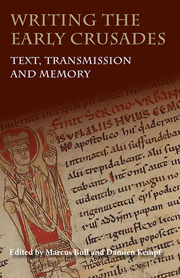Book contents
- Frontmatter
- Contents
- Acknowledgements
- List of Contributors
- List of Abbreviations
- Introduction
- Baldric of Bourgueil and the Familia Christi
- Guibert of Nogent, Albert of Aachen and Fulcher of Chartres: Three Crusade Chronicles Intersect
- Understanding the Greek Sources for the First Crusade
- The Monte Cassino Tradition of the First Crusade: From the Chronica Monasterii Casinensis to the Hystoria de via et recuperatione Antiochiae atque Ierusolymarum
- Nova Peregrinatio: The First Crusade as a Pilgrimage in Contemporary Latin Narratives
- What Really Happened to Eurvin de Créel's Donkey? Anecdotes in Sources for the First Crusade
- Porta Clausa: Trial and Triumph at the Gates of Jerusalem
- The Historia Iherosolimitana of Robert the Monk and the Coronation of Louis VI
- Towards a Textual Archaeology of the First Crusade
- Robert the Monk and his Source(s)
- Rewriting the History Books: The First Crusade and the Past
- The Ideal of Knighthood in English and French Writing, 1100–1230: Crusade, Piety, Chivalry and Patriotism
- Index
Guibert of Nogent, Albert of Aachen and Fulcher of Chartres: Three Crusade Chronicles Intersect
Published online by Cambridge University Press: 05 May 2014
- Frontmatter
- Contents
- Acknowledgements
- List of Contributors
- List of Abbreviations
- Introduction
- Baldric of Bourgueil and the Familia Christi
- Guibert of Nogent, Albert of Aachen and Fulcher of Chartres: Three Crusade Chronicles Intersect
- Understanding the Greek Sources for the First Crusade
- The Monte Cassino Tradition of the First Crusade: From the Chronica Monasterii Casinensis to the Hystoria de via et recuperatione Antiochiae atque Ierusolymarum
- Nova Peregrinatio: The First Crusade as a Pilgrimage in Contemporary Latin Narratives
- What Really Happened to Eurvin de Créel's Donkey? Anecdotes in Sources for the First Crusade
- Porta Clausa: Trial and Triumph at the Gates of Jerusalem
- The Historia Iherosolimitana of Robert the Monk and the Coronation of Louis VI
- Towards a Textual Archaeology of the First Crusade
- Robert the Monk and his Source(s)
- Rewriting the History Books: The First Crusade and the Past
- The Ideal of Knighthood in English and French Writing, 1100–1230: Crusade, Piety, Chivalry and Patriotism
- Index
Summary
Guibert of Nogent wrote his crusade chronicle, God's Deeds through the Franks, in 1107–8, while living in his former monastery of Saint-Germer de Fly. Exiled from his abbacy in Nogent, he had a great deal of time on his hands, which he filled by writing a scholarly, elegant history of the crusade. His main source was the Gesta Francorum. Like his contemporaries Robert the Monk and Baldric of Bourgueil, Guibert found the Gesta Francorum dissatisfying, particularly in terms of style. On factual matters, by contrast, he stuck close to his source – sometimes to his frustration. The author of the Gesta Francorum, for example, fails to include the name of Bishop Adhemar of Le Puy, and somehow at Saint-Germer Guibert had difficulty tracking down anyone who knew it. Not until near the end of Book II could he write, according to a crusade veteran, ‘that precious man was called “Aymar”’. The passage is emblematic of Guibert's overall historical method: he rewrote the Gesta Francorum and supplemented it, where possible, with information from eyewitnesses. By the end of 1108, he had largely finished the book. Since his exile ended at the same time, he was able to return to Nogent to present the final product to Bishop Lisiard of Soissons.
- Type
- Chapter
- Information
- Writing the Early CrusadesText, Transmission and Memory, pp. 24 - 37Publisher: Boydell & BrewerPrint publication year: 2014



